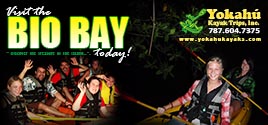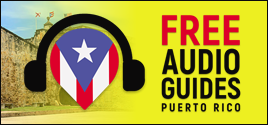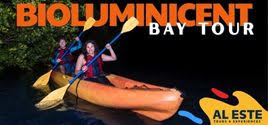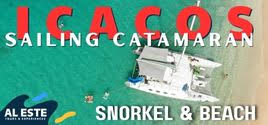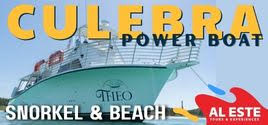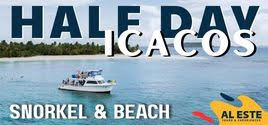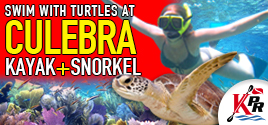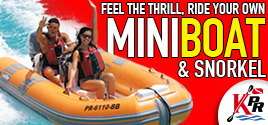Visit a Manatee Rehabilitation Center
We went on the “general” tour, but they now also offer a longer and more Hands on tour called “Caretaker for the day” where you can help prepare and feed the manatee! Also, how many and what animals you see at the center all depends on who needs rehabilitating at any given time.
I love animals, and I have a special place in my heart for marine mammals – though, we have seen wild manatees only a few times in the waters around Puerto Rico.
The manatee species is endemic to Puerto Rico, but they are in danger of extinction due to their being struck by motorboats and from the loss of coastal habitat. Fewer than 600 manatees remain in the waters around Puerto Rico. So, sometimes, these amazing creatures need a little help from us humans.
That is where the Centro de Conservación de Manatíes en la Universidad Inter Americana de Puerto Rico (Manatee Conservation Center at the Inter American University of Puerto Rico) comes in. Among other things, they help out manatees (and other marine animals) in need of medical attention. You can go visit their manatee rehabilitation center and see the amazing work they are doing … and meet the manatees “in person”!
Background Info
The Puerto Rico Manatee Conservation Center (PRMCC) is located on the Bayamon campus of Inter American University of Puerto Rico. It is a small place, run by Dr Mignucci, where he and a group of dedicated volunteers rescue, rehabilitate, and care for hurt, or orphaned manatees from Puerto Rico and the surrounding Caribbean area.
The primary goal of the Center is to rehabilitate the manatees until the are healthy enough to be released back into the wild. The secondary goal of the Center is to educate people about manatees, and to promote responsible actions toward our ocean’s inhabitants through educational tours of the facility.

As of our visit in February 2015, they had 3 manatees at the Center — 2 young Caribbean manatees and an adult Florida manatee (Guacara). Their residents change as rehabilitated manatees are released back to the ocean and new ones arrive at the Center.
Except Guacara, who was rescued from Florida, where he was badly hurt by a motorboat. But Guacara was too badly injured and would not survive in the wild. I guess he is their official mascot! UPDATE 3/24- Sadly, Guacara has died after 14 years of living at the Center.
The famous Moises and Tuque (both of whom still seen in the waters around Puerto Rico) are some of their rehabilitated success stories.
Our Visit
We were greeted by our guide, who started right away explaining to us about the facility, who they are, and what they do. They are permitted by the DRNA/F&W to do this work. She took us into the “kitchen area” where she told us about the dietary requirements of the manatees, and the food they feed to the manatees at the Center.

Adult manatees can eat about 100 pounds of fruit and vegetables per day! They need to calculate all the caloric needs of each animal for each meal to make sure they are getting all the needed calories and nutrients. They bottle feed the babies milk until they can eat solid food.
How much they eat at each meal is monitored and logged. They have special tools to help teach the pups what they would learn naturally from their mother in the wild … like how to forage for food off the ocean floor. It is not as easy as just throwing some lettuce into a pool!
After learning about the manatees’ diets, we walked through the “lab/office” area. We met more of the volunteers while they were doing their daily tasks.
The Center is involved in many aspects of manatee conservation, such as population counts, and tracking released animals. They are affiliated with other “wildlife” agencies in Puerto Rico, Federal agencies in the States, and in the Caribbean.

We then made our way to the outside pool area where the manatees are kept. They told us all about the water filtration system, the typical food manatees eat in the wild, lots of information about manatees in general, the equipment they use for rehabilitation, and the tracking equipment (transponders, etc) that are attached to the manatees when they are finally released.
Next, we got to “meet” the manatees, and learn their stories of how they ended up at the Center.
These gentle creatures are so interesting, and the PRMCC has gone through so much work to make the manatees’ lives better.
All during our visit, the guide answered our million questions. They have lots of school classes through the Center (as well as families), and they do a great job teaching and answering questions. This education of the “next generation” is going to be the make it or break it for the future of manatees. They teach respect and empathy for the manatees, and the need to protect their environment.

People need to learn that, while it is exciting to see these creatures in the wild, they must do it in a way that does not disturb or harass the manatees. As more people become aware of conservation, the better everyone’s lives will be.
Recently, Puerto Rico has designated the manatee as their national mammal, and September 7th is the official “Day of the Conservation of the Caribbean Manatee in Puerto Rico”. Additionally, about 100 reduce speed buoys have been placed in the manatees’ natural habitat.
It is a start, and with the help of PRMCC, the manatees will hopefully have a fighting chance for a survival!
“In the end we will conserve only what we love; we will love only what we understand; and we will understand only what we have been taught”. — Baba Dioum
Your Donation Matters

The people who work at the PRMCC are volunteers, and the Center receives no funding for neither the feeding nor care of the manatees.
They offer tours of the Center in exchange for a donation for the manatees. Those donations are used to provide food, vitamins, and health care for the manatees while they are being cared for at the Center.
Tours can be conducted for school groups, or for individuals (families, etc). Tours are available in English or Spanish.
Details
Each type of visit involves a donation per person. Book the “general” tours or the Caretaker for the Day tour (For the general public) PRMCC website online. They have a similar one for school educational visits at reduced price (call for info/prices). There is free parking at the Center.
Reservations are required! Make reservations for either type of tour at PRMCC website online. Tours of the Center are offered Tuesday through Saturday, 3-4 times a day, starting at 9am. Advance reservations are required.
The general tour lasts about 1 hour. They ask you to arrive 15 minutes before your scheduled tour.
You can visit the PRMCC website for more information or to make a reservation. You can also visit the PRMCC Facebook page for more information.
You can contact the PRMCC by emailing ccmprrcv@manatipr.org ask questions or to get more info.
You can call the PRMCC at 787-400-2782 for more information.
The Puerto Rico Manatee Conservation Center is located in the Bayamon campus of the Inter American University. To get there from San Juan, take Route 22 west to Route 5 south to Route 199 west to Route 840 south. The university is on Route 840. The PRMCC is just a little way through the gate, on the left. It is a one-story building that says “Conservation” on the the front.
Click on a placename below to view the location on Google Maps ...
Puerto Rico Day Trips LLC assumes no responsibility regarding your safety when participating in the activities described in this article. Please use common sense! If your mother or that little voice in your head tells you that you are about to do something stupid … then don't do it!



